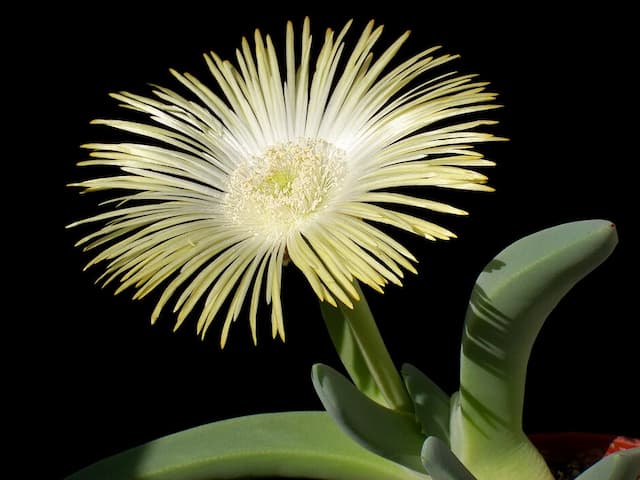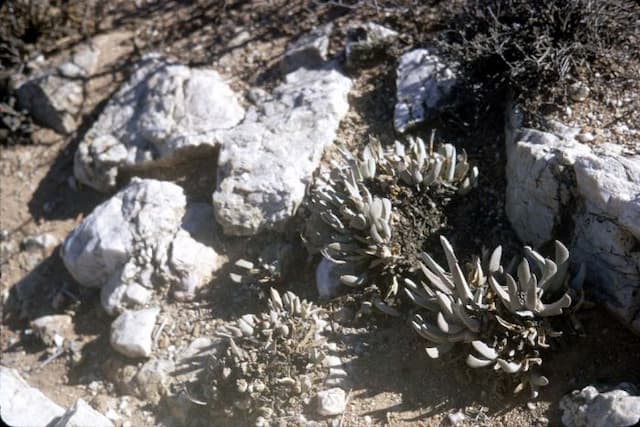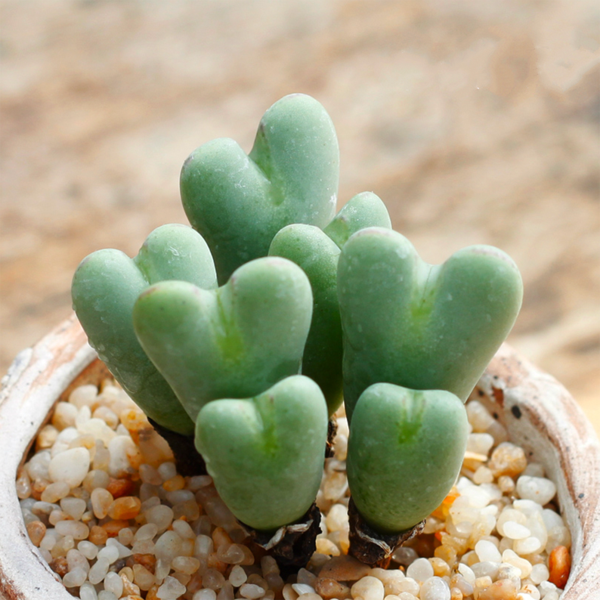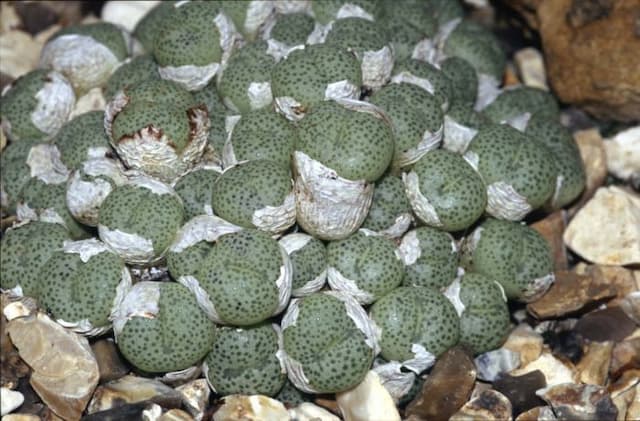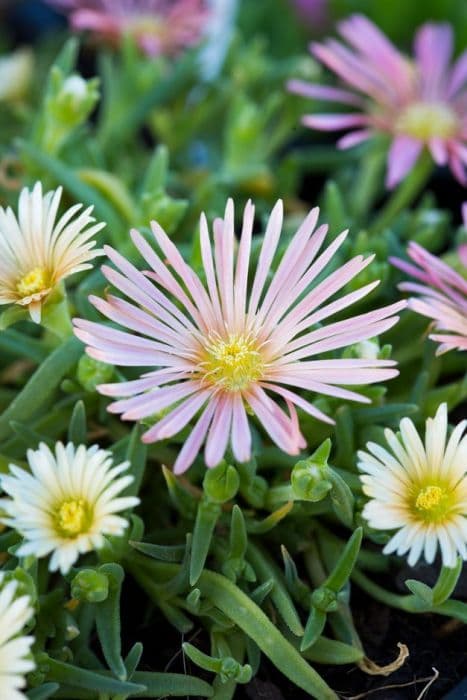Living Stones Lithops salicola

ABOUT
Known commonly as a type of "living stone," the plant tends to blend in with real stones in its native environment. The most striking feature of this plant is its succulent leaves, which are often paired. Each pair forms what looks like a single, split rock, which is fleshly and can exhibit a range of colors, often gray, brown, or green with contrasting patterns that resemble stones. These patterns can include dots, lines, and rings. The surface of the leaves is usually smooth, and the effect of convergence with actual stones is enhanced by the plant's lack of an obvious stem, with the leaves sitting flush against the soil. Occasionally, you might see old, shriveled leaves at the base from previous growth seasons. Flowers emerge from the cleft between the leaves, often bright and daisy-like in appearance, contrasting the stone-like appearance of the leaves. After flowering, new leaf pairs grow, absorbing the nutrients from the old leaves. This process of mimicry and adaptation makes the plant an exceptional example of how some plants have evolved to thrive in specific, and often harsh, environments.
About this plant
 Names
NamesFamily
Aizoaceae
Synonyms
Living Stones, Pebble Plants, Stone Plants
Common names
Mesembryanthemum salicoloides, Lithops salicola var. reticulata, Lithops salicola var. salicola
 Toxicity
ToxicityTo humans
Lithops salicola, commonly known as living stones, is not known to be toxic to humans. There are no widespread reports of poisoning, and they are generally considered safe to keep in households. However, they are not edible and should not be ingested. If accidental ingestion does occur, it is unlikely to result in more than mild gastrointestinal upset. Always consult with a medical professional if ingestion occurs and there is concern for health effects.
To pets
Living stones (Lithops salicola) are not toxic to pets. These succulents do not contain any known toxic compounds that would harm cats, dogs, or other household pets. As such, they are considered safe to have in a home with animals. However, ingestion of non-food items can sometimes lead to gastrointestinal issues in pets, such as vomiting or diarrhea, regardless of toxicity. If a pet ingests part of the plant and experiences such symptoms, it is advisable to consult a veterinarian.
 Characteristics
CharacteristicsLife cycle
Perennials
Foliage type
Evergreen
Color of leaves
Varies
Flower color
White
Height
1 inch (2.5 cm)
Spread
1 inch (2.5 cm)
Plant type
Succulent
Hardiness zones
10
Native area
South Africa
Benefits
 General Benefits
General Benefits- Decorative Aesthetic: Living Stones (Lithops salicola) provide an unusual and intriguing appearance that can serve as a decorative element in homes and gardens.
- Drought Tolerance: Adapted to survive in arid conditions, Living Stones require very little water, making them suitable for dry climates and water-wise gardening.
- Easy Maintenance: With minimal care requirements, Living Stones are easy to maintain, making them ideal for busy or novice gardeners.
- Space Saving: Their small size allows them to fit into tight spaces, making them perfect for small apartments or areas with limited room.
- Educational Value: Living Stones can be used to educate about survival strategies of plants in desert environments, such as water storage and camouflage.
- Collection and Hobby Interest: With various patterns and colors, Living Stones are popular with collectors and hobbyists who enjoy cultivating and propagating rare plant varieties.
 Medical Properties
Medical PropertiesThis plant is not used for medical purposes.
 Air-purifying Qualities
Air-purifying QualitiesThis plant is not specifically known for air purifying qualities.
 Other Uses
Other Uses- Lithops salicola, commonly known as "living stones", can be used as educational tools in botany or horticulture classes to demonstrate succulent adaptations and mimicry.
- These plants can serve as a low-maintenance option for terrariums given their minimal water needs and interesting appearance, simulating a miniature desert landscape.
- Living stones can be given as novel gifts to plant enthusiasts who appreciate rare and unusual plant species.
- They can act as artistic inspiration, providing a unique organic form for artists and designers to replicate in various mediums.
- Lithops salicola can be utilized in research on drought-resistant plant breeding due to their capacity to survive in arid environments with minimal water.
- Due to their unique shapes and textures, these plants can be used in photography workshops to teach macro photography techniques.
- In modern home decor, living stones can be employed as natural elements that complement minimalist and zen interior design themes.
- They can also be part of sensory gardens aimed at stimulating touch, due to the firm, rock-like feel of their leaves.
- Lithops salicola can be used as a passive educational display in museums to showcase the biodiversity and adaptability of plants in extreme environments.
- Finally, these "living stones" can serve as conversation starters in a home or office setting, sparking discussions on botany, conservation, and the natural world.
Interesting Facts
 Feng Shui
Feng ShuiThe Living Stones is not used in Feng Shui practice.
 Zodiac Sign Compitability
Zodiac Sign CompitabilityThe Living Stones is not used in astrology practice.
 Plant Symbolism
Plant Symbolism- Survival and Adaptation - Lithops salicola, commonly known as the "Living Stone," symbolizes an incredible ability to survive and adapt to harsh environments, as these plants are known for their remarkable mimicry and drought resistance.
- Perseverance - The Living Stone represents perseverance due to its slow-growing nature and the ability to live in the same spot for many years despite challenging conditions.
- Patience - With their slow growth and long periods between watering, Living Stones symbolize patience and the reward that comes from waiting for the right moment to thrive.
- Camouflage and Protection - As master mimics blending in with their rocky surroundings, Living Stones symbolize camouflage and the use of protective adaptation as a means to thrive in difficult situations.
- Beauty in Simplicity - They convey the notion that there is beauty in simplicity, with their unassuming appearance and the surprise of their vibrant flowers blooming from what appears to be mere stones.
- New Beginnings - The flowering of Lithops salicola suggests new beginnings and the idea that life can emerge from the most unexpected places.
 Water
WaterLiving Stones, or Lithops salicola, require minimal watering, as they are adapted to arid environments. Water them sparingly, especially during their dormant season in the summer and winter months, when you should avoid watering altogether. In spring and autumn, you can water them about once every 2-3 weeks, or when the soil is completely dry. When you do water, provide just enough to moisten the soil without leaving it soggy, which might be around 2-3 ounces for smaller pots, not to exceed a quart for larger containers. It's crucial to ensure that the pot has good drainage to prevent root rot.
 Light
LightLiving Stones prefer strong, bright light and thrive in conditions that mimic their native habitat. The best spot for Lithops salicola is a south-facing window where they can receive at least four to six hours of sunlight daily. It's essential to provide ample light, especially during the growing seasons of spring and fall, to maintain vibrant colors and proper form.
 Temperature
TemperatureLiving Stones are best kept in temperatures ranging from 65°F to 80°F, which are ideal for their growth. They can tolerate a minimum temperature of about 40°F, but exposure to temperatures below that can be harmful. Conversely, they can survive maximum temperatures of around 100°F as long as proper ventilation and shading are available to prevent overheating and sunburn.
 Pruning
PruningLiving Stones typically do not require pruning due to their unique growth pattern. However, any dead or dried plant matter can be gently removed to promote healthier growth. Prune only when necessary, typically after the old leaves have fully dried up and the new growth has emerged, which is usually in late summer or early fall.
 Cleaning
CleaningAs needed
 Soil
SoilThe best soil mix for the Living Stones (Lithops salicola) should be well-draining and consist of a blend of sandy or gritty soil, potting mix, and pumice or perlite. It's essential to mimic their natural rocky environment. Ideally, the soil pH for Living Stones should be around 5.5 to 6.5.
 Repotting
RepottingLiving Stones (Lithops salicola) should be repotted every few years or when they outgrow their current pot. It is best to repot these plants at the end of their dormancy period, during late summer or early fall.
 Humidity & Misting
Humidity & MistingLiving Stones (Lithops salicola) thrive in low to moderate humidity levels and can tolerate dry air. The best humidity level for these plants is between 40% to 50%.
 Suitable locations
Suitable locationsIndoor
Provide bright light and seldom water.
Outdoor
Full sun to partial shade; very well-drained soil.
Hardiness zone
10-11 USDA
 Life cycle
Life cycleLithops salicola, commonly known as "living stones," begins its life cycle when a seed germinates in early fall, typically after heavy rainfalls. The seedling slowly develops two succulent leaves which form its stone-like appearance, designed to minimize water loss and blend into the surrounding environment. As the plant matures each year, new leaf pairs replace old ones, with a period of dormancy during the hottest and driest months, where the plant reabsorbs nutrients from the old leaves. Once the plant reaches three to five years of age, it becomes capable of flowering, usually around late summer to fall; the flowers are daisy-like, mostly yellow or white, and open in the afternoon and close at sunset. After pollination, the plant produces small capsules containing tiny seeds, which are released when the capsule is wetted by rain. This life cycle continues as the seeds disperse and find suitable crevices to germinate, beginning the process anew.
 Propogation
PropogationPropogation time
Spring-Early Summer
Propogation: Lithops salicola, commonly known as Living Stones, is typically propagated by seeds, as it is the most popular method given the plant's slow growth and rare production of offsets. To propagate Living Stones by seeds, the ideal time is during the warm season, generally in the spring or summer, when temperatures range between 65 and 80 degrees Fahrenheit (18 and 27 degrees Celsius). Sow seeds in a well-draining soil mix, lightly covered with a fine layer of sand or gravel to prevent them from being displaced by water. The soil should be kept moist but not waterlogged, with gentle misting being a preferred method of watering to prevent the seeds from being disturbed. Seedlings will appear in two weeks to a month if the conditions are favorable, requiring careful attention to maintain consistent moisture and avoid direct sunlight until they are well-established.
